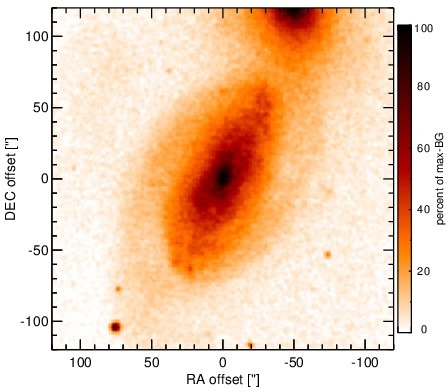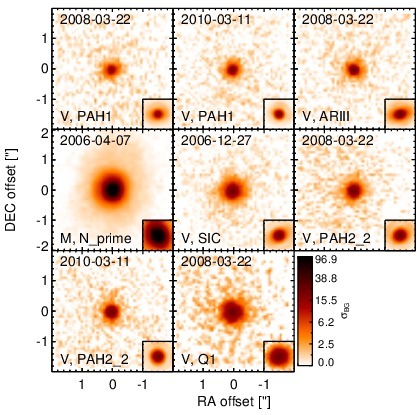Sasmirala Individual Information for NGC 3227
Description
NGC 3227 is a low-inclination barred spiral galaxy at a redshift of z = 0.0039 (D ~ 22.1 Mpc) interacting with NGC 3226. It hosts a circum-nuclear starburst and a well-studied variable Sy 1.5 nucleus [veron-cetty_catalogue_2010] that belongs to the nine-month BAT AGN sample. In addition, NGC 3227 possesses a complex extended NLR with [O III] emission extending to the north-east (PA~ 30∘), which does not align with the double lobe radio emission along a PA~-10∘ [mundell_anisotropic_1995]. Furthermore, the nuclear Hα emission extends along a PA~ 65∘ [gonzalez_delgado_circumnuclear_1997]. The first MIR observations of NGC 3227 were carried out by [kleinmann_infrared_1970] and followed by many others using bolometers [rieke_infrared_1972, rieke_infrared_1978, lebofsky_extinction_1979, cutri_statistical_1985, devereux_infrared_1987, ward_continuum_1987, wright_recent_1988]. Apart from IRAS, also ISO observations are available [perez_garcia_mid-_1998, clavel_2.5-11_2000, domingue_multiwavelength_2003, ramos_almeida_mid-infrared_2007]. The first subarcsecond N-band imaging of the nuclear region was performed with Palomar 5 m/MIRLIN in 1999 by [gorjian_10_2004], where a compact MIR nucleus was detected. The Spitzer/IRAC and MIPS images reveal S-shaped host emission extending from the dominating compact nucleus. Our nuclear IRAC 5.8 μm flux agrees with [gallimore_infrared_2010], while the IRAC 8.0 μm flux is significantly lower but in agreement with the Spitzer/IRS LR spectrum. The latter exhibits prominent PAH features, forbidden emission lines and a red spectral slope in νFν-space, while the presence of silicate features is uncertain (see also [wu_spitzer/irs_2009, gallimore_infrared_2010]). The arcsecond-scale MIR emission of NGC 3227 is thus severely affected or even dominated by star formation. The nuclear region was observed with Michelle in the N’ filter in 2006 [ramos_almeida_infrared_2009], and with VISIR in four N and one Q-band filter throughout 2006, 2008 and 2010 (partly published in [honig_dusty_2010-1]). A compact MIR nucleus was detected in all images, while the deepest image (N’) shows faint elliptically extended emission along the host major axis surrounding the nucleus (PA~-10∘; major axis diameter ~ 3.5arcsec ~ 0.4 kpc). The nucleus itself appears marginally resolved but not significantly elongated (FWHM ~ 15% larger than standard star) in all cases except the ARIII and N’ images, the latter of which was taken in substandard MIR seeing conditions judged from the standard star FWHM. Thus, we classify this object as extended and measure only the unresolved nuclear component, which is on average ~ 50% lower than the Spitzer spectrophotometry and ~ 30% lower than the VISIR LR N-band spectrum presented in [honig_dusty_2010-1]. The latter is in turn consistent with our total nuclear fluxes and exhibits on average ~ 30% lower fluxes than the IRS spectrum. The fact that the VISIR spectrum extracted from the central ~ 70 pc shows still PAH emission indicates the presence of star formation on these scales, which is consistent with the findings of [rodriguez-ardila_hidden_2003] and [davies_star-forming_2006]. In addition, the VISIR spectrum appears to show silicate 10 μm emission as expected for an unobscured AGN. Finally, possible N-band flux variations of NGC 3227 are \⪅14% in the last ~ 35 years from comparison of the historical and the recent data. This is well within the expected dispersion only due to different filters, measurement methods and the feature-rich N-band SED. Interestingly, the nucleus of NGC 3227 was not detected during MIR interferometric observations with MIDI on a short baseline. This indicates that the nuclear MIR emission is dominated by very extended structures at milliarcsecond scales [burtscher_diversity_2013].
- [burtscher_diversity_2013] L. Burtscher, K. Meisenheimer, K. R. W. Tristram, W. Jaffe, S. F. Hönig, R. I. Davies, M. Kishimoto, J.-U. Pott, H. Röttgering, M. Schartmann, G. Weigelt, and S. Wolf. A diversity of dusty AGN tori. data release for the VLTI/MIDI AGN large program and first results for 23 galaxies . A&A , 558 pp. 149, October 2013.
- [clavel_2.5-11_2000] J. Clavel, B. Schulz, B. Altieri, P. Barr, P. Claes, A. Heras, K. Leech, L. Metcalfe, and A. Salama. 2.5-11 micron spectroscopy and imaging of AGNs. implication for unification schemes . A&A , 357 pp. 839–849, May 2000.
- [cutri_statistical_1985] R. M. Cutri and C. W. McAlary. A statistical study of the relationship between galaxy interactions and nuclear activity . ApJ , 296 pp. 90–105, September 1985.
- [davies_star-forming_2006] R. I. Davies, J. Thomas, R. Genzel, F. Mueller Sánchez, L. J. Tacconi, A. Sternberg, F. Eisenhauer, R. Abuter, R. Saglia, and R. Bender. The star-forming torus and stellar dynamical black hole mass in the seyfert 1 nucleus of NGC 3227 . ApJ , 646 pp. 754–773, August 2006.
- [devereux_infrared_1987] Nicholas A. Devereux, E. E. Becklin, and Nick Scoville. Infrared characteristics of the nuclei of normal galaxies . ApJ , 312 pp. 529–541, January 1987.
- [domingue_multiwavelength_2003] Donovan L. Domingue, Jack W. Sulentic, Cong Xu, Joseph Mazzarella, Yu Gao, and Roberto Rampazzo. Multiwavelength insights into mixed-morphology binary galaxies. i. ISOCAM, ISOPHOT, and hα imaging . AJ , 125 pp. 555–571, February 2003.
- [gallimore_infrared_2010] J. F. Gallimore, A. Yzaguirre, J. Jakoboski, M. J. Stevenosky, D. J. Axon, S. A. Baum, C. L. Buchanan, M. Elitzur, M. Elvis, C. P. O'Dea, and A. Robinson. Infrared spectral energy distributions of seyfert galaxies: Spitzer space telescope observations of the 12 μm sample of active galaxies . ApJS , 187 pp. 172–211, March 2010.
- [gonzalez_delgado_circumnuclear_1997] Rosa M. Gonzalez Delgado and Enrique Perez. The circumnuclear region in the seyfert 1 galaxy NGC 3227 . MNRAS , 284 pp. 931–945, February 1997.
- [gorjian_10_2004] V. Gorjian, M. W. Werner, T. H. Jarrett, D. M. Cole, and M. E. Ressler. 10 micron imaging of seyfert galaxies from the 12 micron sample . ApJ , 605 pp. 156–167, April 2004.
- [honig_dusty_2010-1] S. F. Hönig, M. Kishimoto, P. Gandhi, A. Smette, D. Asmus, W. Duschl, M. Polletta, and G. Weigelt. The dusty heart of nearby active galaxies. i. high-spatial resolution mid-IR spectro-photometry of seyfert galaxies . A&A , 515 pp. 23, June 2010.
- [kleinmann_infrared_1970] D. E. Kleinmann and F. J. Low. Infrared observations of galaxies and of the extended nucleus in m82 . ApJL , 161 pp. L203, September 1970.
- [lebofsky_extinction_1979] M. J. Lebofsky and G. H. Rieke. Extinction in infrared-emitting galactic nuclei . ApJ , 229 pp. 111–117, April 1979.
- [mundell_anisotropic_1995] C. G. Mundell, A. J. Holloway, A. Pedlar, J. Meaburn, M. J. Kukula, and D. J. Axon. Anisotropic radio and optical emission in the seyfert nucleus of NGC 3227 . MNRAS , 275 pp. 67–75, July 1995.
- [perez_garcia_mid-_1998] A. M. Perez Garcia, J. M. Rodriguez Espinosa, and A. E. Santolaya Rey. The mid- and far-infrared spectral energy distribution of seyfert galaxies . ApJ , 500 pp. 685, June 1998.
- [ramos_almeida_infrared_2009] C. Ramos Almeida, N. A. Levenson, J. M. Rodríguez Espinosa, A. Alonso-Herrero, A. Asensio Ramos, J. T. Radomski, C. Packham, R. S. Fisher, and C. M. Telesco. The infrared nuclear emission of seyfert galaxies on parsec scales: Testing the clumpy torus models . ApJ , 702 pp. 1127–1149, September 2009.
- [ramos_almeida_mid-infrared_2007] C. Ramos Almeida, A. M. Pérez García, J. A. Acosta-Pulido, and J. M. Rodríguez Espinosa. The mid-infrared emission of seyfert galaxies: A new analysis of ISOCAM data . AJ , 134 pp. 2006–2019, November 2007.
- [rieke_infrared_1972] G. H. Rieke and F. J. Low. Infrared photometry of extragalactic sources . ApJL , 176 pp. L95, September 1972.
- [rieke_infrared_1978] G. H. Rieke. The infrared emission of seyfert galaxies . ApJ , 226 pp. 550–558, December 1978.
- [rodriguez-ardila_hidden_2003] A. Rodríguez-Ardila and S. M. Viegas. Hidden starbursts in seyfert 1 galaxies . MNRAS , 340 pp. L33–L37, April 2003.
- [veron-cetty_catalogue_2010] M.-P. Véron-Cetty and P. Véron. A catalogue of quasars and active nuclei: 13th edition . A&A , 518 pp. 10, July 2010.
- [ward_continuum_1987] Martin Ward, Martin Elvis, G. Fabbiano, N. P. Carleton, S. P. Willner, and A. Lawrence. The continuum of type 1 seyfert galaxies. i - a single form modified by the effects of dust . ApJ , 315 pp. 74–91, April 1987.
- [wright_recent_1988] G. S. Wright, R. D. Joseph, N. A. Robertson, P. A. James, and W. P. S. Meikle. Recent star formation in interacting galaxies. III - evidence from mid-infrared photometry . MNRAS , 233 pp. 1–23, July 1988.
- [wu_spitzer/irs_2009] Yanling Wu, Vassilis Charmandaris, Jiasheng Huang, Luigi Spinoglio, and Silvia Tommasin. Spitzer/IRS 5-35 μm low-resolution spectroscopy of the 12 μm seyfert sample . ApJ , 701 pp. 658–676, August 2009.
Images

Optical image (DSS, red filter). Displayed are the central 4 arcmin with North being up and East to the left. The colour scaling is linear with white corresponding to the median background (BG) and black to the 0.01% pixels with the highest intensity.

Spitzer MIR images. Displayed are the inner 40 arcsec with North being up and East to the left. The colour scaling is logarithmic with white corresponding to median BG and black to the 0.1% pixels with the highest intensity. The label in the bottom left states instrument and central wavelength of the filter in micron (I: IRAC, M: MIPS).

Subarcsecond-resolution MIR images sorted by increasing filter central wavelength. Displayed are the inner 4 arcsec with North being up and East to the left. The colour scaling is logarithmic with white corresponding to median BG and black to the 75% of the highest intensity of all images in units of sig_bg. The inset image (where present; either bottom or top right) shows the central arcsecond of the PSF from the calibrator star, scaled to match the science target. The labels in the bottom left state instrument and filter names (C: COMICS, M: Michelle, T: T-ReCS, V: VISIR).
SEDs


MIR SED. The description of the symbols in all the SED plots (where present) is the following: Grey crosses and solid lines mark the Spitzer/IRAC, MIPS and IRS data. The colour coding of the other symbols is as follows: green for COMICS, magenta for Michelle, blue for T-ReCS and red for VISIR data. Darker-coloured solid lines mark spectra of the corresponding instrument. The black filled circles mark the nuclear 12 and 18 micron continuum emission estimate from the data (where present). The ticks on the top axis mark positions of common MIR emission lines, while the light grey horizontal bars mark wavelength ranges affected by the silicate 10 and 18 micron features.